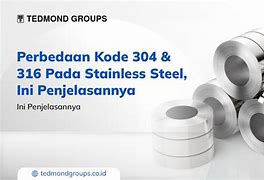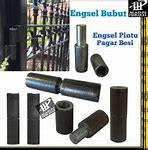
Mengapa Membeli di PT Mitra Jaya Makmur Abadi?
PT Mitra Jaya Makmur Abadi adalah penyedia sistem perpipaan yang terpercaya dan berpengalaman lebih dari 20 tahun dalam industri produk logam. Berikut adalah beberapa alasan mengapa Anda harus membeli pipa stainless steel dari kami:
Dengan berbagai keunggulan dan layanan terbaik, PT Mitra Jaya Makmur Abadi adalah pilihan tepat untuk memenuhi kebutuhan pipa stainless steel Anda. Hubungi Kami untuk detail produk yang Anda butuhkan kepada kami dan temukan produk pipa dan perlengkapanya yang berkualitas yang Anda butuhkan untuk proyek Anda.
Selain pipa ini kami pun menawarkan produk pipa besi / baja lainnya selengkapnya Anda dapat mengunjungi katalog kami pada halaman produk.
Stainless steel that has both austenitic and ferritic phases
Duplex stainless steels[1][2][3][4][5] are a family of stainless steels. These are called duplex (or austenitic-ferritic) grades because their metallurgical structure consists of two phases, austenite (face-centered cubic lattice) and ferrite (body centered cubic lattice) in roughly equal proportions. They are designed to provide better corrosion resistance, particularly chloride stress corrosion and chloride pitting corrosion, and higher strength than standard austenitic stainless steels such as type A2/304 or A4/316. The main differences in composition, when compared with an austenitic stainless steel is that the duplex steels have a higher chromium content, 20–28%; higher molybdenum, up to 5%; lower nickel, up to 9% and 0.05–0.50% nitrogen. Both the low nickel content and the high strength (enabling thinner sections to be used) give significant cost benefits. They are therefore used extensively in the offshore oil and gas industry for pipework systems, manifolds, risers, etc. and in the petrochemical industry in the form of pipelines and pressure vessels. In addition to the improved corrosion resistance compared with the 300 series duplex stainless steels also have higher strength. For example, a Type 304 stainless steel has a 0.2% proof strength in the region of 280 MPa (41 ksi), a 22%Cr duplex stainless steel a minimum 0.2% proof strength of some 450 MPa (65 ksi) and a superduplex grade a minimum of 550 MPa (80 ksi).[6]
Pengaplikasian Pipa Stainless Steel
Pipa stainless steel digunakan di berbagai sektor industri dan aplikasi, antara lain:
Lihat Juga produk Pipa galvanis
Applications of duplex stainless steels
Duplex stainless steels are usually selected for their high mechanical properties and good to very high corrosion resistance (particularly to stress corrosion cracking).
Tabel Berat Pipa Stainless Steel
Berikut adalah tabel berat pipa stainless steel berdasarkan diameter dan ketebalan:
Keunggulan Pipa Stainless Steel
Pipa Stainless Steel memiliki banyak keunggulan, hal ini menyebabkan material ini sangat cocok digunakan / diaplikasikan pada proyek dibidang kontruksi maupun industri. Apa saja keunggulannya berikut yang telah kami rangkum dalam beberapa sumber :
Grades of duplex stainless steels
Duplex stainless steels are usually divided into three groups based on their pitting corrosion resistance, characterised by the pitting resistance equivalence number, PREN = %Cr + 3.3 %Mo + 16 %N.[7]
Sekilas Tentang Pipa Stainless Steel
Pipa stainless steel adalah salah satu material konstruksi yang sangat populer dan banyak digunakan di berbagai industri. Material ini dikenal karena ketahanannya terhadap korosi, kekuatan, serta penampilan yang estetis. Pipa jenis ini terbuat dari campuran baja yang mengandung minimal 10,5% krom, yang memberikan ketahanan terhadap karat dan oksidasi. PT Mitra Jaya Makmur Abadi menyediakan berbagai jenis perpipaam berkualitas yang siap memenuhi kebutuhan proyek Anda.
Chemical compositions
Chemicals composition of grades from EN 10088-1 (2014) Standard are given in the table below:[9]
Lubricants and Corrosion Inhibitors
Lubricants and Corrosion Inhibitors
Lubricants and Corrosion Inhibitors
Lubricants and Corrosion Inhibitors
Lubricants and Corrosion Inhibitors
Lubricants and Corrosion Inhibitors
Definition and classification of Stainless steel coils
A finished steel product known as a coil has been rolled, wound, or coiled after being formed into a sheet or strip. According to current products and international standards, steel coils are divided into cold-rolled steel coils and hot-rolled steel coils, or stainless steel coils, carbon coils, and galvanized steel coils based on the experience gained over the years. The steel coil supplier will then give you access to the following information:
To create hot-rolled steel coils, semi-finished goods must first be rolled, annealed, and reduced to a specific thickness. Pipes, steel doors, and tanks are made of hot-rolled steel, which is also used to make cold-rolled steel.
Cold-rolled steel coils
To remove rust from hot-rolled steel plates, the plates are “pickled” in a mild acid solution, followed by washing, brushing, drying, oiling, uncoiling, and cold rolling through the plate. It is then wrapped into coils after being forced through a size-reduction reduction device.
When it comes to components other than carbon, silicon, manganese, sulfur, and phosphorus, a carbon coil is a form of steel that often contains very little of them. As a result, it lacks a substantial alloying element. Applications in the second grade that don’t have a lot of requirements for surface quality are ideal candidates for carbon coils. Carbon coil steel is available in a range of grades and thicknesses to accommodate the numerous uses for this material.
A hot-rolled or cold-rolled sheet or strip is coated with zinc using either the hot-dipping or electrolytic deposition procedures, which results in the galvanized coil. Typically, the hot dip method’s zinc coating is thick enough to prevent corrosion without additional coating. Except in weakly corrosive situations, materials that have been electronically galvanized cannot be used for corrosion-resistant applications without additional chemical treatment and painting.
Mechanical properties
Mechanical properties from European Standard EN 10088-3 (2014)[9] (for product thickness below 160 mm):
*for thickness ≤ 5 mm (0.20 in)
The minimum yield stress values are about twice as high as those of austenitic stainless steels.
Duplex grades are therefore attractive when mechanical properties at room temperature are important because they allow thinner sections.
map of 128 hrs age hardened duplex stainless steel with the ferrite phase forming the matrix and austenite grains sporadically spread. The ferrite phase volume fraction is 58%.
EBSD map with austenite grains excluded (white). The scale bar is 500 μm. Colours denote the crystal orientation and are taken from the inverse
at the lower right corner.
EBSD map with austenite grains excluded (white). The scale bar is 500 μm. Colours denote the crystal orientation and are taken from the inverse pole figure at the lower right corner. Duplex stainless is widely used in the industry because it possesses excellent oxidation resistance but can have limited toughness due to its large ferritic grain size, and they have hardened, and embrittlement tendencies at temperatures ranging from 280 to 500 °C, especially at 475 °C, where spinodal decomposition of the supersaturated solid ferrite solution into Fe-rich nanophase ( a ´ {\displaystyle {\acute {a}}} ) and Cr-rich nanophase ( a ´ ´ {\displaystyle {\acute {a}}{\acute {}}} ), accompanied by G-phase precipitation, occurs,[13][14][15] which makes the ferrite phase a preferential initiation site for micro-cracks.[16]
Duplex stainless steel grades must be cooled as quickly as possible to room temperature after hot forming to avoid the precipitation of intermetallic phases (Sigma phase in particular) which drastically reduce the impact resistance at room temperature as well as the corrosion resistance.[17]
Alloying elements Cr, Mo, W, Si increase the stability and the formation of intermetallic phases. Therefore, super duplex grades have a higher hot working temperature range and require faster cooling rates than the lean duplex grades.



